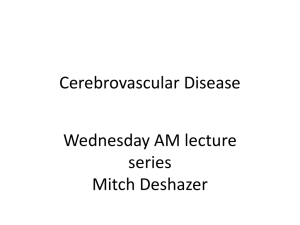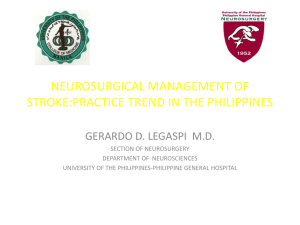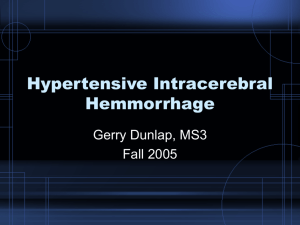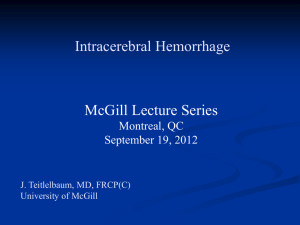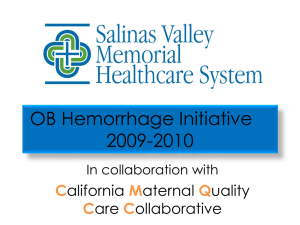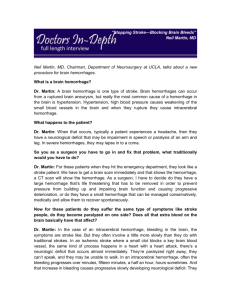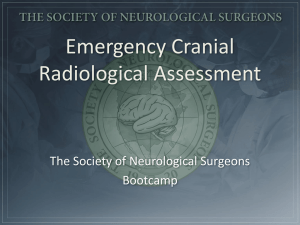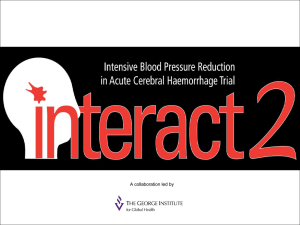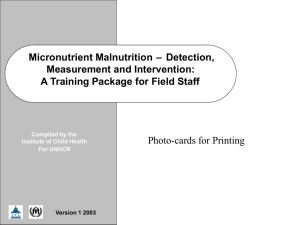Pathophysiology
advertisement
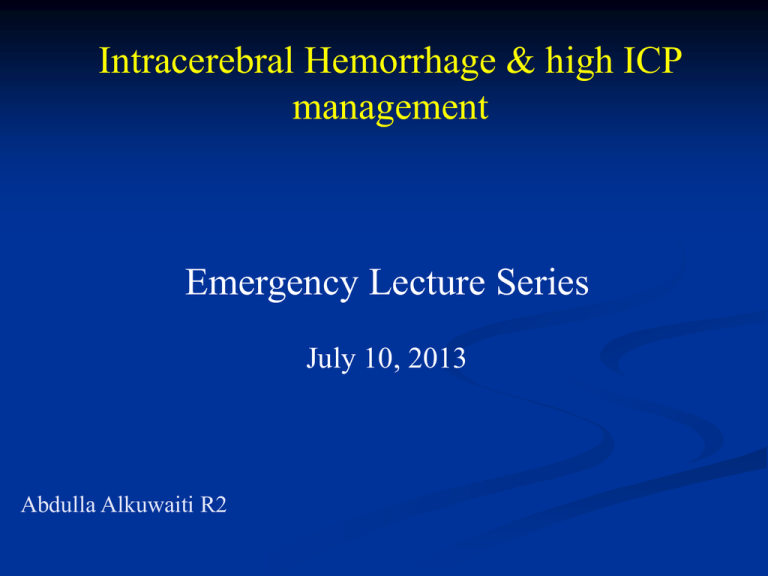
Intracerebral Hemorrhage & high ICP management Emergency Lecture Series July 10, 2013 Abdulla Alkuwaiti R2 Content • • • • • • • Pathophysiology Epidemiology Clinical features Causes/Risk factors Types of ICH Radiological Findings Management/ including increase ICP • Prognosis Pathophysiology • Thrombin and iron, released upon red blood cell (RBC) lysis, are 2 major factors causing brain injury after ICH. • Thrombin at high concentrations kills neurons and astrocytes in vitro. • Hemoglobin degradation can result in iron release. The iron causes marked brain edema, even in small concentration. Ya Hua, “Intracerebral hemorrhage: introduction brain injury afteriIntracerebral hemorrhage, ther role of Thrombin and Iron” Stroke.2007; 38: 759-762 Secondary Damage Hematoma expansion ≥ 80 ml fatal Cerebral edema Secondary injury Epidemiology • Accounts for 15% of strokes in the West and 30% in the East • 12-15 cases per 100,000 per year • More common in Hispanics, Blacks, Asian than in whites Canada: 2008/2009 Total 11%: AGE 20-29: 17%, 30-39: 16%, 40-49: 11%, 50-59: 12%, 60-69: 12%, 70-79: 10%, 80-89: 10%, 90+: 7% Male 53%, female 47% The quality of stroke care in Canada, Canadian stroke network 2011 Clinical Features • Sudden headache +/- N & V • Smooth progressive onset over minutes to hours • Usually during activity • Confusion • Neurodeficit: hemiplegia • Depressed level of consciousness • Seizures Case: 26F Post op Post Angio ICH Score Component ICH score points GCS 3-4 2 5 - 12 1 13 - 15 0 ICH volume ≥ 30 ml 1 ≤ 30 ml 0 IVH yes 1 no 0 Infratentorial 1 Age > 80 1 Mortality and ICH Score Classification of ICH SECONDARY PRIMARY (78-88%) Hypertensive angiopathy (fibrohyalinosis) Amyloid angiopathy Anticoagulant Associated AVM Aneurysm Cavernoma Neoplasm Coagulopathy Alcoholic liver disease Hemophilia Hemorrhagic infarct Toxic-cocaine Risk factors AGE: Incidence significantly doubles with each decade after age 55. Above 80 years of age risk increases 25 times Gender: more common in men Race: more common in blacks, hispanics, asians, less in whites Previous CVA Alcohol consumption: >3 drinks per day increases the risk of ICH by 7 folds Drugs: cocaine, amphetamine Cigarette smoking does not increase the risk of ICH Risk Factors Oral Anticoagulant: warfarin risk of bleed in afib patient is 2.2% per year Antiplatelets: ASA alone (1.3% per year risk) no significant increase in risk but ASA and plavix together increase risk to 2.4% per year. rTPA: risk of ICH is 6.4% in the next 36hrs Genetic predisposition The E2 and E4 alleles of the apolipoprotein E gene play an important role in the occurrence of certain forms of ICH as labor hemorrhages O’Donnel et al, 2000 Types of Intracerebral Hemorrhage Putaminal hemorrhage (35%) Caudate Hemorrhage (5%) Thalamic Hemorrhage (10-15%) Mesencephalic Hemorrhages (rare) Pontine Hemorrhage (5%) Medullary Hemorrhages (rare) Cerebellar Hemorrhage (5-10%) Lobar Hemorrhage (25%) IVH Extension of ICH to IVH is a common feature of caudate and thalamic hemorrhages, and of large putaminal and lobar hemorrhages Lobar Hemorrhages 2nd most common (25%) Nonhypertensive mechanisms: Young (AVM sympathomimetic agents) Elderly: cerebral amyloid angiopathy Usually subcortical frontal vs parietal vs temporal vs occipital Seizures in up to 28% of patients Mortality rate is lower than other bleeds, and long term functional outcome maybe better. Radiological Findings Spot Sign Radiological Findings Spot sign: predictor of expansion (PREDICT 2012) PPV 61% NPV 78% Sensitivity 51% Specificity 85% Mortality at 3 months was 43·4% (23 of 53) in CTA spot-sign positive versus 19·6% (31 of 158) in CTA spot-sign-negative patients (p=0·002). Demchuk AM, Prediction of haematoma growth and outcome in patients with intracerebral haemorrhage using the CT-angiography spot sign (PREDICT): a prospective observational study. Lancet Neurol. 2012 Apr;11(4):307-14. MRI Brain Management of ICH • ABC ICU admission • Early control of elevated BP • Correction of coagulopathy and platelet abnormalities • Identification and control of urgent surgical issues, such as threatening mass effect, intracranial HTN and hydrocephalus • Definitive diagnosis of the cause of the hemorrhage and definitive treatment of the underling cause General Supportive Care HOB 30° SO2 ≥ 95% Glucose control, hypoglycemia should be avoided T° control ≤ 37.5° C Pain control, sedation Prognosis and Acute Blood Pressure ↑ Early Neurological Deterioration ↓ Functional Outcome (90 days) 1 month mortality (%) 1 month mortality (%) 100 80 60 40 20 0 -117 118-132 133-144 MAP (mm Hg) 145- Fogelhom et al, Stroke, 28: 1396-400, 1997 Okumura et al, J. Hypertension, 23: 1217-23, 2005 Blood Pressure and Hematoma Evolution Target max SBP No Enlargement Hematoma Enlargement 140 mmHg 16 2 150 mmHg 14 1 160 mmHg 22 8 9% p=0.025 30% 170 mmHg 8 5 Ohwaki et al, Stroke, 35: 1353-1367, 2004 Blood pressure control • Blood pressure on initial arrival to the ER and every 15 minutes until blood pressure has stabilized, showed be corrected within 1 hour of presentation. • Target < 180 mmHg • Close blood pressure monitoring (e.g. every 30 to 60 min) should continue for at least the first 24 to 48 hours. • There is evidence demonstrating it is safe to target systolic blood pressure to less than 160 mmHg. American and Best practice canadian guidelines for stroke management BP Control Meds • Labetalol: 10-20mg iv over 2 minutes, then 40-80mg iv every 10 min, until BP is controlled. Max dose 300mg per day. Fu heart rate, avoid bradycardia. • Enalopril iv 0.625 to 1.2 mg every 4-6 hours • Hydralazine iv 10-20mg every 4-6 hours • Nicardipine 5mg/hr titrate by 2.5mg/hr every 5 min to a maximum dose of 15mg/hr • Sodium Nitroprusside: it can increase ICP so to be avoided in neurological emergencies unless everything else fails. Risk of cyanide toxicity can occur with rapid and prolonged infusion. Metabolic acidosis, elevated lactate levels and lactate/pyruvate ratios, and increased mixed venous oxygen content suggest clinical toxicity. Antiepileptics • Clinical seizures should be treated with antiepileptic drugs • Patients with a change in mental status who are found to have electrographic seizures on EEG should be treated with antiepileptic drugs • Prophylactic anticonvulsant medication should not be used American and Best practice canadian guidelines for stroke management Statins The SPARCL trial of high-dose atorvastatin in secondary stroke prevention reported an excess of ICH with active treatment compared with placebo (55 versus 33; P 0.02). 2012 meta-analysis of 31 RCT trial on statin and risk of intracerebral hemorrhage, there was no significant increase Reversing coagulopathies Check Coag and platelets Correct thrombocytopenia below 100, some references say below 75. If on ASA or plavix, should be held and transfused platelets Warfarin should be stopped and treated with prothrombin complex concentrate (PCC) (contains factor 2, 7, 9, 10, protein c and protein s) and Vitamin K 10 mg IV. Fresh-frozen plasma 2-6 units and Vitamin K could be used as alternative if PCC is not available If on heparin best reversed with protamine sulfate (1.0 to 1.5 mg/1000 U heparin American and Best practice canadian guidelines for stroke management Reverse anticoagulation Dabigatran reversal may benefit from PCC but the evidence is weak and efforts should be directed toward improving renal clearance with consideration of hemodialysis in emergency situations. Rivaroxaban and apixaban are more likely to benefit from PCC administration than dabigatran but are unlikely to benefit from hemodialysis. F Robert ‘The role of anticoagulats, antiplatelets, and their reversal strategies in the management of intracerebral hemorrhage’ Neurosurg focus 34 (5): 2013 Factor V11a • • • • Recombinant Factor VIIa Within 4 hours prevents hematoma growth Increases the risk of arterial thromboembolic No clinical benefit for survival or outcome. It is not recommended for use outside of clinical trials at this time American and Best practice canadian guidelines for stroke management Hematoma Evolution and rFVIIa 4.5ml 5.8ml 3.3ml rFVIIa within 4 hours: • Dose dependent attenuation of hematoma expansion • no effect on mRS at 90 days Mayer et al. NEJM 2005; 352: 777-85 Treatment of ICHT Intubation Hyperventilation Sedation Steroids: NO role Osmotic agents Mannitol Hypertonic saline No Δ in outcome Intracranial Pressure control •Elevate the HOB to 30 degrees •Analgesia and sedation, particularly in unstable, intubated patients •ICP monitor should be considered for patients with GCS <8, those with clinical evidence of transtentorial herniation, or those with significant IVH or hydrocephalus. •Osmotic diuretics (eg, mannitol and hypertonic saline solution) •neuromuscular blockade •Goal of maintaining cerebral perfusion pressure (CPP) of 50 to 70 mmHg ICP control The ICP lowering effect of hyperventilation to a PaCO2 of 25 to 30 mmHg is dramatic and rapid. However, the effect only lasts for minutes to a few hours. ICP control Glucocorticoids should not generally be used to lower the ICP in patients with ICH. No improvement in outcome American and Best practice canadian guidelines for stroke management Surgical Indications • Cerebellar bleed: >3cm, and deteriorating, vs brain stem compression, vs hydrocephalus due to ventricular obstruction • Supratentorial ICH evacuation: Controversial • STICH trial: patients assigned to early (within 24hr) surgical hematoma evacuation were slightly more likely to have a favorable outcome at six months compared with initial conservative treatment, but trend did not reach statistical significance. • It should only be considered as a life saving procedure to treat refractory increases in ICP American and Best practice canadian guidelines for stroke management Surgical Indications • Favoring surgery: obtunded-stupor patients, recent onset of hemorrhage, ongoing clinical deterioration, involvement the nondominant hemisphere, location of the hematoma near the cortical surface. • For patients presenting with lobar clots >30 mL and within 1 cm of the surface evacuation of supratentorial ICH by standard craniotomy might be considered • No clear evidence at present indicates that ultra-early removal of supratentorial ICH improves functional outcome or mortality rate. American and Best practice canadian guidelines for stroke management Intra-ventricular Hemorrhage EVD Intra- ventricular rtpa (CLEAR) Case 55F presented with Headache and LOC PROGNOSIS Mortality 35-52% in the first 30 days and half of them in the first 2 days Factors Affecting Prognosis Volume of hemorrhage Hematoma growth Early Neurological deterioration within 48hr Oral Anticoaglants GCS on presentation Age Hemorrhage location Intraventricular hemorrhage Summary ICH Management • Early control of elevated BP • Correction of coagulopathy and platelet abnormalities • Identification and control of urgent surgical issues, such as threatening mass effect, intracranial HTN and hydrocephalus • Definitive diagnosis of the cause of the hemorrhage and definitive treatment of the underling cause Questions Modified Rankin Scale
